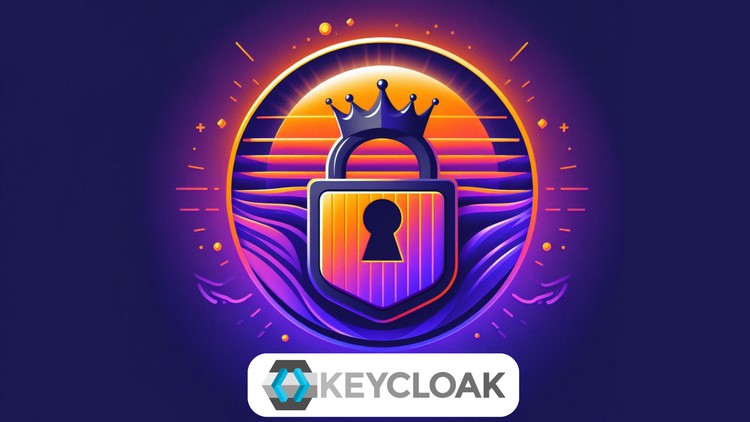Keycloak: SSO Course from Zero to Hero
- Description
- Curriculum
- FAQ
- Reviews
In this course, you will learn Keycloak, an open-source software product that allows single sign-on with Identity and Access Management aimed at modern applications.
Keycloak is an open-source tool that provides identity and access management for web applications and services. It supports standard protocols such as OpenID Connect, OAuth 2.0, and SAML 2.0, and offers features such as single sign-on, user federation, social login, and authorization policies. Here are some possible use cases for Keycloak:
1. Secure microservices and APIs: Keycloak can be used to secure microservices and APIs by providing authentication and access control based on standard protocols like OpenID Connect and OAuth 2.0. This ensures that only authorized users and applications can access your services, helping to maintain the security and integrity of your infrastructure.
2. Integrate with external identity providers: Keycloak can act as an identity broker that allows users to authenticate with external identity providers, such as Google, Facebook, or LDAP. This simplifies the user experience and reduces the need to manage multiple user accounts and passwords. Keycloak can also synchronize user data and attributes from external sources, and map them to roles and groups within Keycloak.
3. Customize and extend Keycloak: Keycloak is highly configurable and extensible, allowing you to customize its look and feel, add new features, and integrate with other systems. You can use themes, templates, and internationalization to change the appearance of Keycloak’s user interface. You can also use extensions, such as SPIs, event listeners, and user storage providers, to add new functionality and logic to Keycloak. You can also use REST APIs and an admin console to manage Keycloak programmatically.
-
6Installation OverviewVideo lesson
-
7Install JavaVideo lesson
-
8Install KeycloakVideo lesson
-
9Install WSLText lesson
-
10Install DockerVideo lesson
-
11Install Keycloak via (Docker)Video lesson
-
12Install Keycloak DocsText lesson
-
13Install PostgreSQL DatabaseVideo lesson
-
14Install pgAdminVideo lesson
-
15Connect Keycloak with PostgreSQL DatabaseVideo lesson
-
16Connect Keycloak with PostgreSQL Database (Docs)Text lesson
-
17Introduction of Keycloak ConfigurationVideo lesson
-
18Use of Keycloak Admin ConsoleText lesson
-
19Keycloak RealmVideo lesson
-
20What is Keycloak Realm ?Text lesson
-
21Keycloak AuthenticationVideo lesson
-
22Identity Providers (IDP)Video lesson
-
23User Federation in KeycloakVideo lesson
-
24Configuring Keycloak ?Quiz
-
25Keycloak ClientsVideo lesson
-
26Keycloak Clients (Docs)Text lesson
-
27Keycloak Clients ScopeVideo lesson
-
28Keycloak Clients Scope (Docs)Text lesson
-
29Realm Roles in KeycloakVideo lesson
-
30Users in KeycloakVideo lesson
-
31Groups in KeycloakVideo lesson
-
32Sessions in KeycloakVideo lesson
-
33Events in KeycloakVideo lesson
-
34Managing Keycloak?Quiz
-
41Introduction to Keycloak custom TemplatesVideo lesson
-
42Best Practices for designing Keycloak Custom TemplatesText lesson
-
43Why we need Keycloak custom templates ?Text lesson
-
44Getting the base theme templateVideo lesson
-
45Customizing your Login PageVideo lesson
-
46Adding Favicon IconVideo lesson
-
47What are Keycloak Custom TemplatesQuiz
-
48Introduction to Keycloak Integration with Full Stack ApplicationVideo lesson
-
49Keycloak Integration with Full Stack Application (Docs)Text lesson
-
50FastAPI Keycloak IntegrationVideo lesson
-
51FastAPI Keycloak Integration (Project Docs)Text lesson
-
52Initialise a React Project (Docs)Text lesson
-
53Initialise a React ProjectVideo lesson
-
54React Repository (Docs)Text lesson
-
55Installing the Keycloak PackagesVideo lesson
-
56Adding KeycloakConfig.js FileVideo lesson
-
57Adding Api.js To make API calls with Keycloak TokenVideo lesson
-
58Fixing the CORS IssueVideo lesson

External Links May Contain Affiliate Links read more





